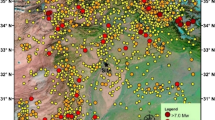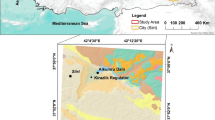Abstract
Probabilistic modelling is gaining increased attention in the field of assessing the landslide hazard due to the ability to account for the spatial and temporal uncertainties related to the variability of geological, hydrological, geotechnical, seismological and geomorphological parameters. In this study, a seismic landslide hazard assessment was carried out for Uttarakhand state, located in the Indian Himalayan region. A methodology was developed to model the parametric uncertainties incorporated in the modified Newmark slope stability analysis model, which considers the rock joint shear strength properties in permanent displacement computation. The uncertainties related to input parameters were taken into account by utilizing statistical distributions to represent these parameters. On a pixel-by-pixel basis, several probability density functions were simulated using the Monte Carlo method, and the simulation results were retained throughout the computation process. As a result, there were no constraints on the mathematical complexity or symmetry of the underlying distributions when casting the derived quantities into probabilistic hazard maps. The hazard map showed the probability of exceedance of seismic slope displacement beyond a threshold value of 5 cm. High probability values were observed in the Middle and Greater Himalayas, emphasizing the likelihood of a large number of earthquake-induced landslides in this region. Finally, the results were validated using the landslide inventory of the 1999 Chamoli earthquake. The prepared seismic landslide hazard map will give infrastructural planners and local authorities a tool for evaluating the risk associated with a seismic landslide for land use planning and taking appropriate mitigation measures to reduce the losses.








Similar content being viewed by others
Code availability
All codes used in the present study are developed by the authors and are available upon request.
Data availability
The datasets generated during and/or analysed during the current study are available from the corresponding author upon reasonable request.
References
ALOSPALSAR (2015) Dataset: ASF DAAC 2015, ALOS PALSAR_ radiometric_terrain_corrected _high_res; includes material © JAXA/METI 2007. Accessed through ASF DAAC 12 December 2021
Ambraseys NN, Menu JM (1988) Earthquake-induced ground displacements. Earthq Eng Struct Dyn 16:985–1006. https://doi.org/10.1002/eqe.4290160704
Arias A (1970) Measure of earthquake intensity. In: Hansen RJ (ed) Seismic design for nuclear power plants. Press, Cambridge, Mass. Massachusetts Inst. of Tech, pp 438–483
Bandis S, Lumsden AC, Barton NR (1981) Experimental studies of scale effects on the shear behaviour of rock joints. Int J Rock Mech Min Sci Geomech Abstr 18:1–21. https://doi.org/10.1016/0148-9062(81)90262-X
Bandis SC, Lumsden AC, Barton NR (1983) Fundamentals of rock joint deformation. Int J Rock Mech Min Sci 20:249–268. https://doi.org/10.1016/0148-9062(83)90595-8
Barnard PL, Owen LA, Sharma MC, Finkel RC (2001) Natural and human-induced landsliding in the Garhwal Himalaya of northern India. Geomorphology 40:21–35. https://doi.org/10.1016/S0169-555X(01)00035-6
Barton N (1973) Review of a new shear-strength criterion for rock joints. Eng Geol 7:287–332. https://doi.org/10.1016/0013-7952(73)90013-6
Barton N (1976) The shear strength of rock and rock joints. Int J Rock Mech Min Sci 13:255–279. https://doi.org/10.1016/0148-9062(76)90003-6
Barton N, Choubey V (1977) The shear strength of rock joints in theory and practice. Rock Mech Felsmechanik Mécanique Des Roches 10:1–54. https://doi.org/10.1007/BF01261801
Bilham R (2004) Earthquakes in India and the Himalaya: tectonics, geodesy and history. Ann Geophys 47:839–858. https://doi.org/10.4401/ag-3338
Caccavale M, Matano F, Sacchi M (2017) An integrated approach to earthquake-induced landslide hazard zoning based on probabilistic seismic scenario for Phlegrean Islands (Ischia, Procida and Vivara), Italy. Geomorphology 295:235–259. https://doi.org/10.1016/j.geomorph.2017.07.010
Cornell CA (1968) Engineering seismic risk analysis. Bull Seismol Soc Am 58:1583–1606. https://doi.org/10.1785/bssa0580051583
Crespellani T, Madiai C, Vannucchi G (1998) Earthquake destructiveness potential factor and slope stability. Géotechnique 48:411–419. https://doi.org/10.1680/geot.1998.48.3.411
Cui Y, Liu A, Xu C, Zheng J (2019) A modified newmark method for calculating permanent displacement of seismic slope considering dynamic critical acceleration. Adv Civ Eng 2019:1–10. https://doi.org/10.1155/2019/9782515
Du G, Zhang Y, Yang Z, Iqbal J, Tong B, Guo C, Yao X, Wu R (2017) Estimation of seismic landslide hazard in the Eastern Himalayan syntaxis region of Tibetan plateau. Acta Geol Sin - Engl 91(2):658–668. https://doi.org/10.1111/1755-6724.13124
Du S, Hu Y, Hu X (2009) Measurement of joint roughness coefficient by using profilograph and roughness ruler. J Earth Sci 20:890–896. https://doi.org/10.1007/s12583-009-0075-3
GSI (2021) Bhukosh-the spatial data portal and a geophysical data repository. https://bhukosh.gsi.gov.in/Bhukosh/Public. Accessed 2 Aug 2021
Gupta K, Satyam N (2022) Estimation of Arias intensity and peak ground acceleration (PGA) using probabilistic seismic hazard assessment of Uttarakhand state (India). Arab J Geosci 15:437. https://doi.org/10.1007/s12517-022-09733-9
Hsieh SY, Lee CT (2011) Empirical estimation of the newmark displacement from the arias intensity and critical acceleration. Eng Geol 122:34–42. https://doi.org/10.1016/j.enggeo.2010.12.006
Jibson RW (1993) Predicting earthquake-induced landslide displacements using Newmark’s sliding block analysis. Transp Res Rec 9–17
Jibson RW (2007) Regression models for estimating co-seismic landslide displacement. Eng Geol 91:209–218. https://doi.org/10.1016/j.enggeo.2007.01.013
Jibson RW, Harp EL, Michael JA (2000) A method for producing digital probabilistic seismic landslide hazard maps. Eng Geol 58:271–289. https://doi.org/10.1016/S0013-7952(00)00039-9
Khattri KN (1987) Great earthquakes, seismicity gaps and potential for earthquake disaster along the Himalaya plate boundary. Tectonophysics 138:79–92. https://doi.org/10.1016/0040-1951(87)90067-9
Kumar S, Gupta V, Kumar P, Sundriyal YP (2021) Co-seismic landslide hazard assessment for the future scenario earthquakes in the Kumaun Himalaya, India. Bull Eng Geol Environ 80:5219–5235. https://doi.org/10.1007/s10064-021-02267-6
Liu J, Shi J, Wang T, Wu S (2018) Seismic landslide hazard assessment in the Tianshui area, China, based on scenario earthquakes. Bull Eng Geol Environ 77:1263–1272. https://doi.org/10.1007/s10064-016-0998-8
Ma S, Xu C (2019) Assessment of co-seismic landslide hazard using the Newmark model and statistical analyses: a case study of the 2013 Lushan China Mw6.6 earthquake. Nat Hazards 96(1):389–412. https://doi.org/10.1007/s11069-018-3548-9
Mankelow MM, Murphy W (1998, 2008) Using GIS in the probabilistic assessment of earthquake triggered landslide hazards. J Earthq Eng 2(4):593–623. https://doi.org/10.1080/13632469809350336
Miles SB, Keefer DK (2009) Evaluation of CAMEL — comprehensive areal model of earthquake-induced landslides. Eng Geol 104:1–15. https://doi.org/10.1016/j.enggeo.2008.08.004
Mohamad ET, Alshameri BA, Kassim KA, Saad R (2011) Shear strength behaviour for older alluvium under different moisture content. Electron J Geotech Eng 16 F:605–617
Nath RR, Das N, Satyam DN (2021) Impact of main boundary thrust (MBT) on landslide susceptibility in Garhwal Himalaya: a case study. Indian Geotech J 51:746–756. https://doi.org/10.1007/s40098-021-00522-x
Nayek PS, Gade M (2021) Seismic landslide hazard assessment of central seismic gap region of Himalaya for a M w 8.5 scenario event. Acta Geophys 69:747–759. https://doi.org/10.1007/s11600-021-00572-y
Newmark NM (1965) Effects of earthquakes on dams and embankments. Géotechnique 15:139–160. https://doi.org/10.1680/geot.1965.15.2.139
Rajendran K, Parameswaran RM, Rajendran CP (2018) Revisiting the 1991 Uttarkashi and the 1999 Chamoli, India, earthquakes: implications of rupture mechanisms in the central Himalaya. J Asian Earth Sci 162:107–120. https://doi.org/10.1016/j.jseaes.2018.04.012
Ramamurthy T (2014) Engineering in rocks for slopes, foundations and tunnels, Third Edit. PHI Learning Private Limited
Refice A, Capolongo D (2002) Probabilistic modeling of uncertainties in earthquake-induced landslide hazard assessment. Comput Geosci 28:735–749. https://doi.org/10.1016/S0098-3004(01)00104-2
Rodriguez-Peces MJ, Garcia-Mayordomo J, Azanon JM, Jabaloy A (2011) Regional hazard assessment of earthquake-triggered slope instabilities considering site effects and seismic scenarios in Lorca Basin (Spain). Environ Eng Geosci 17:183–196. https://doi.org/10.2113/gseegeosci.17.2.183
Romeo R (2000) Seismically induced landslide displacements: a predictive model. Eng Geol 58:337–351. https://doi.org/10.1016/S0013-7952(00)00042-9
Saygili G, Rathje EM (2008) Empirical predictive models for earthquake-induced sliding displacements of slopes. J Geotech Geoenvironmental Eng 134:790–803. https://doi.org/10.1061/(asce)1090-0241(2008)134:6(790)
Saygili G, Rathje EM (2009) Probabilistically based seismic landslide hazard maps: An application in Southern California. Eng Geol 109(3–4):183–194. https://doi.org/10.1016/j.enggeo.2009.08.004
Singh TN, Kainthola A, Venkatesh A (2012) Correlation between point load index and uniaxial compressive strength for different rock types. Rock Mech Rock Eng 45:259–264. https://doi.org/10.1007/s00603-011-0192-z
Valdiya KS (1988) Tectonics and evolution of the central sector of the Himalaya. Philos Trans R Soc London Ser a, Math Phys Sci 326:151–175. https://doi.org/10.1098/rsta.1988.0083
Vose D (1996) Quantitative risk analysis: a guide to Monte Carlo simulation modeling. Wiley, Chichester, England
Wang H, Wang G, Wang F et al (2008) Probabilistic modeling of seismically triggered landslides using Monte Carlo simulations. Landslides 5:387–395. https://doi.org/10.1007/s10346-008-0131-6
Wilson DK, Keefer RC (1985) Predicting areal limits of earthquake-induced landsliding. In: Ziony JI (ed) Earthquake hazards in the Los Angeles region - an Earth-science perspective. U.S. Geological Survey Professional Paper, 316–345
Zang M, Qi S, Zou Y et al (2020) An improved method of Newmark analysis for mapping hazards of co-seismic landslides. Nat Hazards Earth Syst Sci 20:713–726. https://doi.org/10.5194/nhess-20-713-2020
Zhang L (2017) Engineering properties of rocks, Second Edi. Elsevier Ltd
Funding
The work was financially supported by the Department of Science and Technology, India, under response project number NGP/LS/TPN-34229/2019.
Author information
Authors and Affiliations
Corresponding author
Ethics declarations
Competing interests
The authors declare no competing interests.
Rights and permissions
Springer Nature or its licensor (e.g. a society or other partner) holds exclusive rights to this article under a publishing agreement with the author(s) or other rightsholder(s); author self-archiving of the accepted manuscript version of this article is solely governed by the terms of such publishing agreement and applicable law.
About this article
Cite this article
Gupta, K., Satyam, N. & Gupta, V. Probabilistic physical modelling and prediction of regional seismic landslide hazard in Uttarakhand state (India). Landslides 20, 901–912 (2023). https://doi.org/10.1007/s10346-022-02013-3
Received:
Accepted:
Published:
Issue Date:
DOI: https://doi.org/10.1007/s10346-022-02013-3




